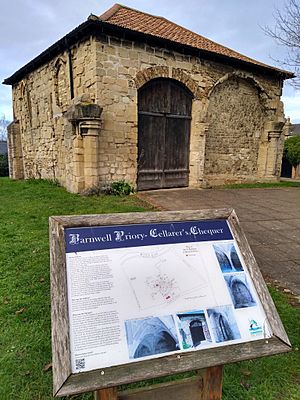Barnwell Priory facts for kids
Barnwell Priory was an old religious building in Cambridgeshire, England. It was home to a group of Christian monks called Augustinian canons. These canons followed a special set of rules for their lives. Today, only a few parts of the priory still stand. These include a building from the 13th century and some old walls found in Abbey House. An unknown writer, known as the Barnwell chronicler, lived here and wrote about the reign of King John.
Contents
History of Barnwell Priory
How the Priory Began
Around the year 1092, a man named Picot of Cambridge started the priory. He was like a sheriff for Cambridgeshire. It began in St Giles' Church near Cambridge Castle. An old book, the Liber Memorandorum Ecclesie de Bernewelle, tells us a story. It says Picot's wife, Hugolina, was very sick. She promised to start a religious house if she got better. She did get better! So, Picot gave money and land to the priory, likely because of his wife's promise.
The first monks, called canons regular, followed the Rule of St Augustine. There were six of them at first. They probably came from other similar religious houses nearby. Picot gave them money from taxes and control over some churches.
Growing and Moving the Priory
After Picot and Hugolina passed away, the priory came under the control of King Henry I. He then gave it to a man named Pain Peverel. Pain Peverel had big plans for the priory. He convinced King Henry to give him land on the eastern edge of Cambridge. This allowed him to move and make the priory much bigger. It then became known as Barnwell Priory.
More land was given to the priory by local landowners. Over time, the priory grew in size and became very strong. Eventually, there were 30 canons living there. Barnwell also held a yearly event called the Midsummer Fair. This fair brought in more money for the priory.
Barnwell Priory and Learning
Barnwell Priory had a busy writing room, called a scriptorium. It also had a large library filled with books. Because the priory owned a lot of land, there was much legal work to do. All these activities helped the early University of Cambridge get started.
Much of what we know about the daily lives of Augustinian monks in England comes from the Barnwell Observances. These were rules and customs written down in the 13th century.
Challenges and End of the Priory
The priory was quite wealthy. Because it owned so much land, it became a target during the Peasants' Revolt in 1381. This was a big uprising by common people. The English Parliament even met at the priory for a short time in 1388.
Barnwell Priory was officially closed on November 11, 1538. This was part of a larger event called the Dissolution of the Monasteries. During this time, King Henry VIII closed many religious houses in England. The priory buildings were later given to different people. Over time, they fell into ruin and were mostly destroyed by 1810.
Images for kids
See also
- Leper Chapel, Cambridge, also in Barnwell








